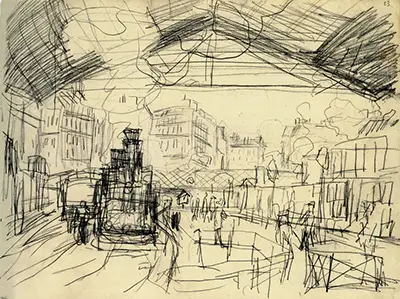This is the case for Monet's sketch of the Gare Saint-Lazare. This sketch is significant because it is part of one of Monet's most famous series.
Starting in 1877, Monet created eleven impressionist paintings of the station. The series shows the famous station at different times of the day and from different points of view. This particular sketch, done in pencil or graphite on paper, is from the view of the suburban line.
The Gare Saint-Lazare is the second busiest railway station in Paris, behind Gare du Nord. Approximately 275,000 people pass through the station every day. Situated in the 8th arrondissement, Gare Saint-Lazare was built in 1837 and designed by Juste Lisch, an architect.
Eugene Flachat was the general contractor. Like Monet, many other Impressionist painters drew inspiration from the station in the 1870s and 1880s because they lived nearby.
Monet's sketchbooks gained in popularity in 2007 with help from the Sterling and Francine Clark Art Institute in Williamstown, Massachusetts. The Art Institute created an exhibition on unknown Monet pieces to draw attention to the artist's creative process from sketch to final pastel or painting piece.
Much like a writer taking notes, the sketchbooks demonstrate the drafting process of what eventually became the famous oil on canvas painting of the same name, The Gare Saint-Lazare.
It is interesting to note that the sketch measures 25.5cm X 34 cm while the final painting measures 75cm X 105cm. Monet was able to take a small sketch and turn it into a large, colorful painting. This is another appreciation viewers can get from looking at Monet's sketchbooks.
The sketch also allows viewers to see all the details that go into an impressionist painting. While not as easily visible in the final painted product, Monet sketched details of the city of Paris through the station in the background.
The smoke, which was a focal point of the Gare Saint-Lazare series, hides the buildings once paint is applied. The sketch also shows how the busyness of a sketch can be transformed with some painting into an almost serene scene of a train station.
Although Monet is typically known for his Impressionist paintings of nature and plein-air landscapes, this city-based sketch still shows his characteristic artistic practices.
Like the rest of his paintings throughout his career, Monet is still able to show his understanding of how light moves and changes in the station rather than in nature. This was one of the purposes of his career.
The sketch of the Gare Saint-Lazare is housed in Musée Marmottan-Monet in the 16th arrondissement of Paris.
It is considered the most important Monet museum in the world. Visitors can see 94 canvas paintings, 29 drawings and eight sketchbooks, including the one with the sketch of the Gare Saint-Lazare. The finished painting is held in the Musée d'Orsay, also in Paris.


